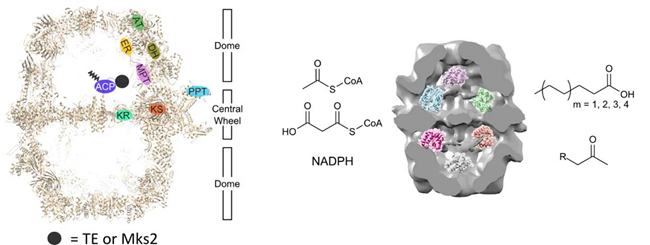Fatty acids are essential for life, and useful for production of biofuels and diverse oleochemicals. To synthesize fatty acid from small metabolites, nature develops complicated biosynthetic machinery. Among fatty acid synthases (FASs) found in nature, the fungal type I FASs are the most efficient, because of the spatial proximity of all seven catalytic enzyme domains (AT, ER, DH, MPT, KS, KR, PPT) and a tethered acyl-carrier protein (ACP) domain. As fungal type I FASs have all catalytic centers embedded into a complicated scaffolding matrix, it remains challenging to manipulate them for new function.
During an on-going project studying molecular bases of lipid overproduction by oleaginous yeasts, Prof. ZHAO Zongbao and his co-workers at Dalian Institute of Chemical Physics, CAS, found that the red yeast Rhodosporidium toruloides contains a novel FAS, RtFAS, with two ACPs and unusual genetic structure (Nat. Commun. 2012, 3, 1112). However, Prof. Grininger Martin of Goethe University Frankfurt and Prof. ZHAO later showed that RtFAS assembles into the typical fungal FAS structure by cryo-electron microscopy analysis (Protein Sci. 2015, 24, 987).

Design and strategy for engineering fungal fatty acid synthases (FASs) to synthesize tailored oleochemicals
(Image by ZHU Zhiwei)
In the current study, Prof. ZHAO teamed up with Prof. Nielsen Jens of Chalmers University of Technology and Prof. Grininger, demonstrated that duplicated ACP in RtFAS are redundant in terms of fatty acid biosynthesis. Researchers replaced either ACP with a short chain thioesterase (TE) from bacteria and showed that the engineered RtFAS can overproduce short/medium chain fatty acids. Similarly, when either ACP was replaced by a methylketone synthase (Mks2), the engineered RtFAS produced long chain methyl ketones. Importantly, this modification strategy was generalized towards other fungal type I FASs, and various modified FASs showed new functions as expected (Nat. Chem. Biol., doi:10.1038/nchembio.2301). This study facilitated new opportunities to engineer fatty acid biosynthetic machinery for expanded product portfolio.
This work was financially supported by National Natural Foundation of China (21325627). (Text and Image by ZHU Zhiwei)